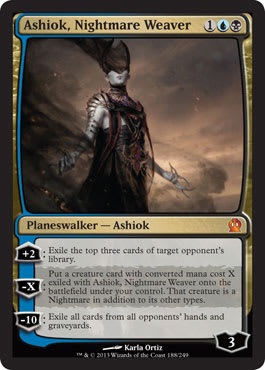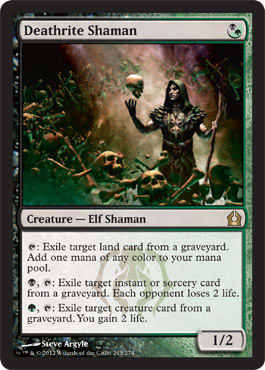Last week, I had the chance to talk about my new Magic hideaway, Magic Online (MTGO) and although it has been a learning experience, this week, we will be returning to the physical world. The market online has a number of differences from the real-world market, and those two markets can be played against each other to maximize profits.
Last week, in the article found here, I talked about how to maximize your returns while still playing as much Magic as possible. For the online market, this can be far more forgiving, as the availability to sell is immediate, meaning there is no lag time in which your cards can drop and your cards can be turned down if being processed. While there are some negatives—such as this one—I still prefer paper Magic for investing, as I like being able to physically see what I am moving—perhaps it’s just an old tick I have never kicked.
Much of what I covered last week does translate over particularly well, though, and there is far more opportunity to buy in to a spike in paper, as you can purchase more than four copies at once from most retailers, allowing you to amass large quantities quickly with little effort. The downside, of course, is that you have to wait for them to be shipped and hope that if the card spikes before your order is packaged that they still honor the price. With this in mind, it is best to try to be very early to the party when looking to invest in Standard, as once a card spikes, you will have more than enough time to sell before the market cools off. This is also different than digital cards, as a price spike can quickly be followed by a price drop even as quickly as that day if the deck does not pan out. In real life, once a card has risen on a buy list, it is unlikely to sink in price very quickly.
Another correlation you can make between the two comes in bulk pricing. Unlike MTGO, the physical market will treat casual cards better, but overall, bulk is still the same standardized price. This means if a card is a quarter to fifty cents in real life, it is likely to be between five and ten cents online. Knowing these prices can let you move in on some speculative targets without investing much. Unlike paper Magic, it does take a significant amount of play for a card to break bulk online, and even to have a bulk rare hit twenty-plus cents can be a fine turnover at times. With all of the added cost in real life—such as travel, postage, and time spent buy-listing or shopping them around—it can make these numbers seem far worse. This means I am more willing to speculate online, as the margin you can lose is lower, and the turnover is quick enough to make the dollar-or-two profit worth it.
With all of this talk about why MTGO is superior to physical cards, you may think I am supporting the movement away from the physical world. Even with all of these benefits, there is just a limitation to how much you can move without starting bots and dumping thousands into the market. This limits most people from really making much online if they are just looking to casually invest or sustain. On top of that, there is little trading to be had on Magic Online, meaning you are less likely to be able to diligently increase the value of your collection without help from the market.
Another aspect of physical Magic that I prefer is collections. First of all, nothing is more enjoyable than the opening of a five row to start the dig. Hidden treasures await the patient; although Magic Online used to have a market to exploit back in the day, it has tightened up, and there is little chance of buying a “collection” without hooking a local or scouring Craigslist. This is where the big money is in paper Magic that allows you, as a trader, to not just sustain, but grow your outlet—whether that be moving into retail or into another format, such as Modern.
Most people I talk to have recently been taking advantage of redemption to allow them to flush out sets, but with the recent changes to the redemption process, it seems less likely prices will dip as hard. I will be keeping an eye on the market through the end of Theros block to see how much it mimics Return to Ravnica block, but as the popularity of Magic increases, it seems many prices are holding or even increasing as fewer people are redeeming sets.
This does not mean there is no good time to get in on cards in paper, but I would usually read the singles market individually and pick up proven cards when they are in a bit of a lull rather than rely on redemption. This means you need to be paying even more attention to coverage—or at the very least reading articles that talk about the trends and what decks are on the way down. Picking up cards that have shown success when they are low—such as Ashiok, Nightmare Weaver and Xenagos, the Reveler—now can prove much like MTGO to net you money down the line. The advantage of having the cards in real life is that you can many times move these cards for a premium when they spike again, as demand is then at a high, and they are probably sold out. This type of markup does happen to some extent online, but it is usually corrected before it can be too easily exploited.
It should also be noted that, with rotation, it seems many cards are taking a smaller drop than expected if they see much Eternal play—this means it is even more difficult to evaluate a card’s post-rotation price if you do not keep an eye on other metagames. This can be solved by doing some research to see how much a card relied on Standard to see results as opposed to other cards. A great example of this would be comparing Boros Reckoner to Deathrite Shaman. I expect Reckoner to hold between $5 and $10 through most of its life, but I would not be surprised to see it dip below that directly after rotation. Deathrite Shaman, on the other hand, which has even had talks of bans in older formats, relies very little on the current Standard results to hold a steady price. This means we can expect Deathrite to experience far less of a drop, if any, directly after rotation, and that makes them much safer to buy into now. This used to be far less relevant, as older formats had much less of a following, but with Modern being a Pro Tour Qualifier format that has been the poster child for competitive Magic this past year, I can see cards taking far less of a hit.
The last thing I want to talk about this week is knowing how and when to abandon a deck that you may still enjoy but that you know is on the way out. I usually look at a frame and see what the expensive pieces are and then evaluate exactly how important to the strategy they are and how much I expect them to dip. If you can find an easy replacement, that is great, but if not, I will usually use that time to invest in cards that are cheap and likely to spike, and I then use a small portion of the old deck’s fund to build a tier-two consistent—yet cheap—deck, such as mono-red. This is, unfortunately, not going to be an option for some people, but if you can at least evaluate the meta when choosing what you want to play and base some of your merit on how well a card pool overall will hold value, it can still be feasible to build a competitive, tier-one deck without wrecking yourself. You get to a point at which you have to look at how much you would have to win to make up for how much you are spending, and if that amount does not seem desirable, it may be best to either find cheaper decks or to dump cards earlier and take a short break between rotations.
As always, thank you for reading, and join me again next week for another interview—this time on a site that I believe even the most casual of players and investors can appreciate. I will return the week after that with the usual financial news and trends. If you have any questions or comments, as always, feel free to leave them below or send me a tweet. Enjoy the holidays, and stay warm; Michigan is a foot deep currently in snow, and I am hoping for a spontaneous Grand Prix Orlando after the beginning of the year. Thank again for reading, and have a great rest of the year!
Ryan Bushard
@CryppleCommand on Twitter

























